chili
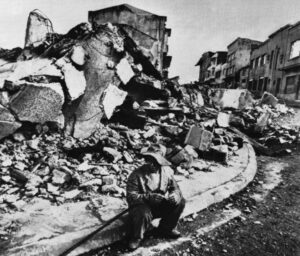
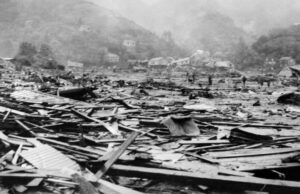 I would never have considered that an earthquake in Chili could affect Hawaii, which is 6,593 miles away, but on May 23, 1960, that seemingly huge distance suddenly became very small. When a 9.5 magnitude earthquake hit Chili on May 22, 1960, thousands of people lost their lives, and a giant tsunami was triggered. By the next day, that tsunami had traveled across the Pacific Ocean and killed an additional 61 people in Hilo, Hawaii. That distance and the amount of devastation seems incredible to me.
I would never have considered that an earthquake in Chili could affect Hawaii, which is 6,593 miles away, but on May 23, 1960, that seemingly huge distance suddenly became very small. When a 9.5 magnitude earthquake hit Chili on May 22, 1960, thousands of people lost their lives, and a giant tsunami was triggered. By the next day, that tsunami had traveled across the Pacific Ocean and killed an additional 61 people in Hilo, Hawaii. That distance and the amount of devastation seems incredible to me.
The earthquake, which involved a severe plate shift, caused a large displacement of water just off the coast of southern Chile at 3:11pm. The resulting wave, traveling at speeds in excess of 400 miles per hour, moved west and north. The damage to the west coast of the United States was estimated at $1 million, but there were no deaths there.
In 1948, the Pacific Tsunami Warning System was established in response to another deadly tsunami. It worked properly and warnings were issued to Hawaiians six hours before the deadly wave was expected to arrive. Unfortunately, some people ignored the warnings, as always seems to happen. Some other people actually headed to the coast in order to view the wave…like the warning was actually an announcement of a coming attraction. The tsunami arrived only a minute after it was predicted, and it absolutely destroyed Hilo Bay on the island of Hawaii.
People really don’t fully understand just how much destructive power water has, until they see it in action. When the waves hit Hilo Bay, they were thirty-five-feet high. They were so strong that they bent parking meters to the ground and wiped away most of the buildings. When the wave hit a 10-ton tractor, it was swept out to sea like it was made of Styrofoam. you would think that boulders would be sturdy enough to hold back the waves, but the 20-ton boulders that made up the seawall were easily moved 500 feet. The 61 people who lost their lives were in Hilo…the hardest hit area of the island chain.
With all of that destruction, you might be inclined to think that the waves would have lost power, and to a degree, I suppose they did. Nevertheless, the tsunami continued to race further west across the Pacific. Even given a ten-thousand-mile distance from the earthquake’s epicenter, Japan still wasn’t able to provide enough warning time to get the people out of harm’s way. The wave hit Japan at about 6:00pm, more than a full day after the earthquake. The tsunami struck the Japanese islands of Honshu and Hokkaido. The wave’s power was still enough to crushing 180 people, and to leave 50,000 more homeless. In Japan, it caused $400 million in 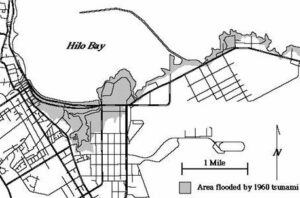
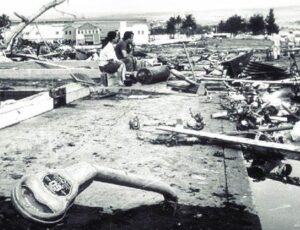 damages. With everything destroyed by this one earthquake and the subsequent tsunami, you would think that people would finally learn to stay away from the shore during a tsunami warning, but every year people lose their lives because they decided to cross paths with waves…be it from tsunamis, hurricanes, and other floods. Water is a force to be reckoned with. It should be considered very dangerous.
damages. With everything destroyed by this one earthquake and the subsequent tsunami, you would think that people would finally learn to stay away from the shore during a tsunami warning, but every year people lose their lives because they decided to cross paths with waves…be it from tsunamis, hurricanes, and other floods. Water is a force to be reckoned with. It should be considered very dangerous.
 On October 13, 1972 a plane crashed somewhere in the Andes Mountains. That isn’t such an unusual event, but the crash was the last part of this event that was not unusual. Flight 571 was en route from Uruguay to Chili at the time it went down. The Uruguayan Air Force plane was chartered by the Old Christians Club to transport the team from Montevideo, Uruguay to Santiago, Chile. On October 12 the twin-engined Fairchild turboprop left Carrasco International Airport. The plane was carrying 5 crew members and 40 passengers. In addition to club members…friends, family, and others were also on board, having been recruited to help pay the cost of the plane. Because of poor weather in the mountains, they were forced to stay overnight in Mendoza, Argentina, before departing at about 2:18 pm the following day, October 13th. Although Santiago was located to the west of Mendoza, the Fairchild was not built to fly higher than approximately 22,500 feet. Because the Andes mountains were higher than that, the pilots plotted a course south to the Pass of Planchón, where the aircraft could safely clear the Andes mountains. An hour after takeoff, the pilot notified air controllers that he was flying over the pass, and shortly thereafter he radioed that he had reached Curicó, Chile, some 110 miles south of Santiago, and had turned north. However, the pilot had misjudged the location of the aircraft, which was still in the Andes mountains. Unaware of the mistake, the controllers cleared him to begin descending in preparation for landing. Then suddenly, the Chilean control tower was unable to contact the plane.
On October 13, 1972 a plane crashed somewhere in the Andes Mountains. That isn’t such an unusual event, but the crash was the last part of this event that was not unusual. Flight 571 was en route from Uruguay to Chili at the time it went down. The Uruguayan Air Force plane was chartered by the Old Christians Club to transport the team from Montevideo, Uruguay to Santiago, Chile. On October 12 the twin-engined Fairchild turboprop left Carrasco International Airport. The plane was carrying 5 crew members and 40 passengers. In addition to club members…friends, family, and others were also on board, having been recruited to help pay the cost of the plane. Because of poor weather in the mountains, they were forced to stay overnight in Mendoza, Argentina, before departing at about 2:18 pm the following day, October 13th. Although Santiago was located to the west of Mendoza, the Fairchild was not built to fly higher than approximately 22,500 feet. Because the Andes mountains were higher than that, the pilots plotted a course south to the Pass of Planchón, where the aircraft could safely clear the Andes mountains. An hour after takeoff, the pilot notified air controllers that he was flying over the pass, and shortly thereafter he radioed that he had reached Curicó, Chile, some 110 miles south of Santiago, and had turned north. However, the pilot had misjudged the location of the aircraft, which was still in the Andes mountains. Unaware of the mistake, the controllers cleared him to begin descending in preparation for landing. Then suddenly, the Chilean control tower was unable to contact the plane.
The pilot basically found himself caught with high mountains all around him…mountains that he could not climb over. When the plane tried to climb out the wings were clipped by the peaks, and the plane crashed in an unknown location. Because the Chilean control tower thought the plane was much further south, they weren’t even sure where to look. To make matters worse, the white plane was extremely difficult to see against the white snow. Search and rescue efforts from the sky were almost impossible…despite the survivors’ attempts to become noticeable. After 11 days, it was assumed that all of the 45 passengers and crew were dead, so search and rescue efforts ceased. The passengers had access to a radio, and when they heard the news of the search 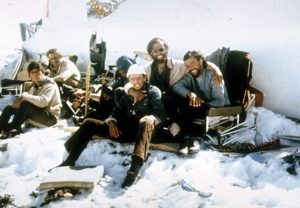 being called off, they were devastated. The crash killed 12 people instantly, leaving 33 survivors to try to stay alive until help could come. A number of the survivors were injured. At an altitude of approximately 11,500 feet, the group faced snow and freezing temperatures. There was no heat, and they only had each other to depend on. While the plane’s fuselage was largely intact, it provided limited protection from the freezing temperatures they faced. Food was scarce…mainly candy bars and wine. Even with rationing, those were gone in about a week. Now the survivors faced the most horrifying decision of their lives. Do they stay alive at all costs, including eating the bodies of the dead for food, or do they simply give up and starve to death? After a heated discussion, the starving survivors resorted to eating the corpses. Their survival instincts had kicked in, even though they knew they might be condemned by the world. Nevertheless, they would probably never forgive themselves anyway, so what the world decided made no real difference. Over the next few weeks six others died, and further disaster struck on October 29, when an avalanche buried the fuselage and filled part of it with snow, causing eight more deaths.
being called off, they were devastated. The crash killed 12 people instantly, leaving 33 survivors to try to stay alive until help could come. A number of the survivors were injured. At an altitude of approximately 11,500 feet, the group faced snow and freezing temperatures. There was no heat, and they only had each other to depend on. While the plane’s fuselage was largely intact, it provided limited protection from the freezing temperatures they faced. Food was scarce…mainly candy bars and wine. Even with rationing, those were gone in about a week. Now the survivors faced the most horrifying decision of their lives. Do they stay alive at all costs, including eating the bodies of the dead for food, or do they simply give up and starve to death? After a heated discussion, the starving survivors resorted to eating the corpses. Their survival instincts had kicked in, even though they knew they might be condemned by the world. Nevertheless, they would probably never forgive themselves anyway, so what the world decided made no real difference. Over the next few weeks six others died, and further disaster struck on October 29, when an avalanche buried the fuselage and filled part of it with snow, causing eight more deaths.
It was decided that someone would have to walk out and tell the officials that they were still alive. On December 12, with just 16 people still alive, three passengers set out for a 10 day journey to find help, though one later returned to the wreckage. After a difficult trek, the other two men finally came across three herdsmen in the village of Los Maitenes, Chile, on December 20. However, the Chileans were on the opposite side of a river, the noise of which made it hard to hear. The herdsmen indicated that they would return the following day. Early the next morning, the Chileans reappeared, and the two groups communicated by writing notes on paper that they then wrapped around a rock and threw across the water. The survivors’ initial note began, “I come from a plane that fell in the mountains.” The Chileans must have heard about the crash, and were most likely stunned to find that there were actually survivors. They hurried to notified authorities, and on December 22 two helicopters were sent to the wreckage. Six survivors were flown to safety, but bad weather delayed the eight others from being rescued until the next day. The 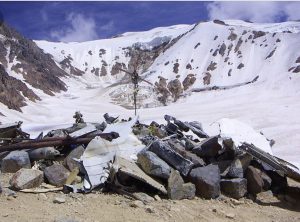 rescue was called the Miracle of the Andes. In the resulting media frenzy, the survivors revealed that they had been forced to commit cannibalism. Many people were outraged until one of the survivors claimed that they had been inspired by the Last Supper, in which Jesus gave his disciples bread and wine that he stated were his body and his blood. This helped soften public opinion, and the church later absolved the men. After watching the movie based on this event, I wondered how any of the rest of us would have handled that situation. We should never be too quick to judge people in such a situation, because we might find that given the same circumstances, we might do the exact same thing.
rescue was called the Miracle of the Andes. In the resulting media frenzy, the survivors revealed that they had been forced to commit cannibalism. Many people were outraged until one of the survivors claimed that they had been inspired by the Last Supper, in which Jesus gave his disciples bread and wine that he stated were his body and his blood. This helped soften public opinion, and the church later absolved the men. After watching the movie based on this event, I wondered how any of the rest of us would have handled that situation. We should never be too quick to judge people in such a situation, because we might find that given the same circumstances, we might do the exact same thing.
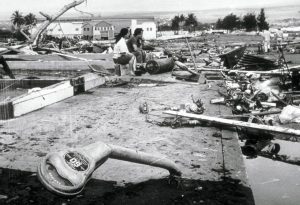 These days, scientist and inventors have collaborated to develop early warning systems for just about any possible disaster, and when everything works as it should, and people heed the warnings, loss of life can often be avoided. Having the technology is great, but technology can’t make human beings do the right things…unfortunately. On May 22, 1960, twelve years after tsunami warnings were developed, and with the warning system in good working order, a massive 9.5 earthquake struck off the coast of Chili. It was the largest earthquake ever recorded. Unfortunately, we don’t really have an earthquake warning, and so without warning, 1655 people lost their lives in Chili and 3,000 injured in the quake. Two million people were made homeless, and damage was estimated at $550 million. The earthquake, involving a severe plate shift, caused a large displacement of water off the coast of southern Chile at 3:11pm. Traveling at speeds in excess of 400 miles per hour, the tsunami moved west and north. On the west coast of the United States, the waves caused an estimated $1 million in damages, but were not deadly. Everyone assumed that the worst was over.
These days, scientist and inventors have collaborated to develop early warning systems for just about any possible disaster, and when everything works as it should, and people heed the warnings, loss of life can often be avoided. Having the technology is great, but technology can’t make human beings do the right things…unfortunately. On May 22, 1960, twelve years after tsunami warnings were developed, and with the warning system in good working order, a massive 9.5 earthquake struck off the coast of Chili. It was the largest earthquake ever recorded. Unfortunately, we don’t really have an earthquake warning, and so without warning, 1655 people lost their lives in Chili and 3,000 injured in the quake. Two million people were made homeless, and damage was estimated at $550 million. The earthquake, involving a severe plate shift, caused a large displacement of water off the coast of southern Chile at 3:11pm. Traveling at speeds in excess of 400 miles per hour, the tsunami moved west and north. On the west coast of the United States, the waves caused an estimated $1 million in damages, but were not deadly. Everyone assumed that the worst was over. 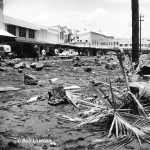
Nevertheless, warnings were sent to the Hawaiian islands. The Pacific Tsunami Warning System properly and warnings were issued to Hawaiians six hours before the wave’s expected arrival. The response of some people, however, was reckless and irresponsible. Some people ignored the warnings, and others actually headed to the coast in order to view the wave. Arriving 15 hours after the quake, only a minute after predicted, the tsunami destroyed Hilo Bay, on the island of Hawaii. Thirty five foot waves bent parking meters to the ground and wiped away most buildings, destroying or damaging more than 500 homes and businesses. A 10 ton tractor was swept out to sea. Reports indicate that the 20 ton boulders making up the sea wall were moved 500 feet. Sixty-one people died in Hilo, the worst-hit area of the island chain. Damage was estimated at $75 million. This tsunami caused little damage elsewhere in the islands, where wave heights were in the 3-17 foot range. The tsunami continued to race further west across the Pacific. Ten thousand miles away from the earthquake’s epicenter. Japan, received warning, but wasn’t able to warn the people in harm’s way. At about 6pm, more than a day after the quake, the tsunami hit the Japanese islands of Honshu and Hokkaido. The  crushing wave killed 180 people, left 50,000 more homeless and caused $400 million in damages. The Philippines, also hit, saw 32 people dead or missing.
crushing wave killed 180 people, left 50,000 more homeless and caused $400 million in damages. The Philippines, also hit, saw 32 people dead or missing.
Tsunami warnings definitely save lives, but only if people will heed the warnings. As long as people decide that the warning doesn’t apply to them, and give in to their curiosity to go have a look, there will continue to be deaths. It seems a great shame that inventors and scientist work so hard to make a warning to save lives, and then some people refuse to do what is necessary to be safe after they have been warned. I simply don’t understand how people can ignore these warnings and take a chance with their lives.
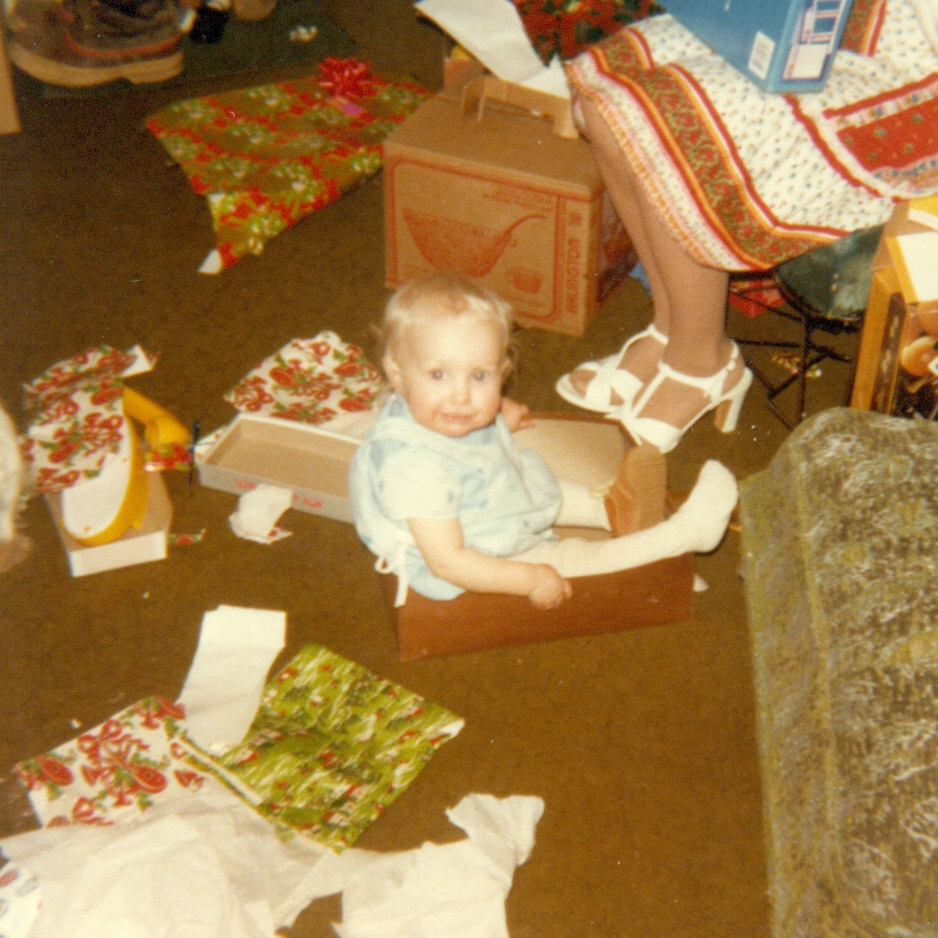

 Christmas Eve traditions can vary from family to family. My husband, Bob’s family always got together for a chili dinner on Christmas eve. Then they opened the presents, and the kids spent the rest of the evening playing with their new toys while all the parents sat around visiting. Sometimes Santa Clause would even show up, which was always a big hit among the little ones. Christmas morning was a day to relax and for the kids to play, while their parents prepared the huge Christmas dinner, and after dinner, all you could think of was how badly you wanted to lay down and sleep…especially when you had eaten two such dinners that day. Christmas dinner was just that way. It really should be followed with a nice long nap, stretched out on the couch to give the belly room.
Christmas Eve traditions can vary from family to family. My husband, Bob’s family always got together for a chili dinner on Christmas eve. Then they opened the presents, and the kids spent the rest of the evening playing with their new toys while all the parents sat around visiting. Sometimes Santa Clause would even show up, which was always a big hit among the little ones. Christmas morning was a day to relax and for the kids to play, while their parents prepared the huge Christmas dinner, and after dinner, all you could think of was how badly you wanted to lay down and sleep…especially when you had eaten two such dinners that day. Christmas dinner was just that way. It really should be followed with a nice long nap, stretched out on the couch to give the belly room.
As a little girl, Christmas eve was a time when we got to open one gift…always pajamas…which ensured good pictures on Christmas morning. We spent time singing Christmas carols. Our Christmas gifts were opened on Christmas morning. I think I always liked that way better, because the anticipation continued to build all night, and then we still had to wait for Mom and Dad to wake up and get things going in the morning. Of course, we really had no idea that they were awake before we were. I think they were just as excited as we were. When it came to Christmas, they were big kids too.
For my grandparents, Hattie and George Byer, as well as my niece, Raylynn Williams and her husband, Doug, 

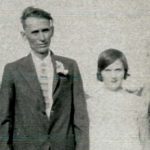 Christmas Eve meant celebrating their wedding anniversary. For Grandma and Grandpa, a Christmas Eve wedding was probably more a matter of having family already gathered, and a wedding being held so people didn’t have to travel twice. For Raylynn, getting married on Christmas Eve was a way of honoring her grandparents…a way of sharing something special with them, even though they were both in Heaven by the time she married. It was like having them there at the wedding, and I’m sure that was exactly what Raylynn was thinking as she planned her special day.
Christmas Eve meant celebrating their wedding anniversary. For Grandma and Grandpa, a Christmas Eve wedding was probably more a matter of having family already gathered, and a wedding being held so people didn’t have to travel twice. For Raylynn, getting married on Christmas Eve was a way of honoring her grandparents…a way of sharing something special with them, even though they were both in Heaven by the time she married. It was like having them there at the wedding, and I’m sure that was exactly what Raylynn was thinking as she planned her special day.
Our daughter Corrie Petersen, her husband, Kevin, and their kids like the tradition we have of opening one gift, and then the rest on Christmas morning, and they have the added excitement of going to Kevin’s mom’s after our house. It really keeps them hopping. Our daughter, Amy Royce, her husband, Travis, and their kids like to watch a movie while eating cheese and sausage with crackers after the gifts are opened on Christmas Eve. For Bob and me…after the rush of Christmas Eve chili with the Schulenberg family, and of everyone coming for the traditional Christmas Eve gift opening session, it’s time to sit down and relax a while before everything starts in the morning, because Christmas dinner is held at our house now. Since my sisters, our families, and I have a party a week or so early, like the Byer family, we all spend Christmas with our own families now. With my 

 parents in Heaven, the big day shifted to us. We love having everyone share it with us. Traditions change as families change, and it will continue to change in the future. The main thing is to enjoy the tradition, while remembering the reason for the season, the birth of our Lord, Jesus Christ.
parents in Heaven, the big day shifted to us. We love having everyone share it with us. Traditions change as families change, and it will continue to change in the future. The main thing is to enjoy the tradition, while remembering the reason for the season, the birth of our Lord, Jesus Christ.
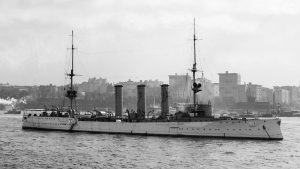 In any war, there are certain weapons, ships, planes, or vehicles that are somewhat, if not totally, feared by the enemy, and World War I was no exception. The Germans has a couple of light cruisers, the Dresden and the Emden. These cruisers were the fastest ships in the German Imperial Navy, capable of traveling at speeds of up to 24.5 knots. They weighed in at 3,600 tons, and they were two of the first German ships to be built with modern steam-turbine engines. The British actually had faster ships, but the Dresden had managed to avoid them…until March 14, 1915, that is. The Dresden was put in service in 1909, and kept very busy. Between August 1, 1914 and March 1915 the Dresden traveled over 21,000 miles.
In any war, there are certain weapons, ships, planes, or vehicles that are somewhat, if not totally, feared by the enemy, and World War I was no exception. The Germans has a couple of light cruisers, the Dresden and the Emden. These cruisers were the fastest ships in the German Imperial Navy, capable of traveling at speeds of up to 24.5 knots. They weighed in at 3,600 tons, and they were two of the first German ships to be built with modern steam-turbine engines. The British actually had faster ships, but the Dresden had managed to avoid them…until March 14, 1915, that is. The Dresden was put in service in 1909, and kept very busy. Between August 1, 1914 and March 1915 the Dresden traveled over 21,000 miles.
In the summer of 1914, the Dresden was patrolling the Caribbean Sea. Its assignment was to safeguard German investments and German citizens living abroad in the region. Then, on July 20, during a bitter civil war in Mexico, the Dresden was called upon to give safe passage to Mexican president, Victoriano Huerta, by transporting him and his family as they escaped to Jamaica, where they received asylum from the British government. Then came news from Europe of Austria’s ultimatum to Serbia and the imminent possibility of war. The German’s put the fleet on alert. By the first week of August the nations of Europe were at war. The Dresden was sent to South America to attack British shipping interests there, and it sunk several merchant ships as it traveled to Cape Horn, at the southern tip of Chile. The Dresden eluded the British naval squadron in 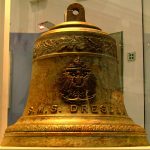 the region, commanded by Rear Admiral Sir Christopher Cradock. In October, the ship joined Admiral Maximilian von Spee’s German East Asia Squadron at Easter Island in the South Pacific. On November 1, Spee’s squadron, including Dresden, scored a crushing victory over the British in the Battle of Coronel, sinking two cruisers with all hands aboard, including Cradock, who went down with his flagship, Good Hope.
the region, commanded by Rear Admiral Sir Christopher Cradock. In October, the ship joined Admiral Maximilian von Spee’s German East Asia Squadron at Easter Island in the South Pacific. On November 1, Spee’s squadron, including Dresden, scored a crushing victory over the British in the Battle of Coronel, sinking two cruisers with all hands aboard, including Cradock, who went down with his flagship, Good Hope.
Just five weeks later, the Dresden was the only German ship to escape destruction at the Battle of the Falkland Islands on November 8, when the British light cruisers Inflexible and Invincible, commanded by Sir Doveton Sturdee, sank four of von Spee’s ships. Lost were Scharnhorst, Gneisenau, Leipzig and Nurnberg. As a crew member of Dresden wrote later of watching one of the other ships sink, “Each one of us knew he would never see his comrades again, no one on board the cruiser can have had any illusions about his fate.” Then the Dresden escaped under cover of bad weather south of the Falkland Islands.
Dresden consistently avoided capture by the British navy over the next several months, while sinking a number of cargo ships and then seeking refuge in the network of channels and bays in southern Chile. In need of repairs, the Dresden put into an island off the Chilean coast, in Cumberland Bay on March 8th. Captain, Fritz Emil von Luedecke, had decided the repairs were necessary in the wake of such heavy and extended use. Captain von Luedecke sent out many messages asking for fuel in the hopes of reaching any passing coal ships in the area, but the messages were picked up the British ships, Kent and Glasgow six days later. After a  hurried search, Kent and Glasgow found Dresden. When Kent opened fire, Dresden sent a few shots back, but soon raised the white flag of surrender. They knew they had no chance against the Kent in their current condition. A German representative negotiated a truce with the British sailors to stall for time, and von Luedecke ordered his crew to abandon the ship and scuttle it. Dresden sank slowly at first, then sharply listed to the side. Amid cheers from both the British on board their two ships and the German sailors that had escaped onto land, Dresden disappeared beneath the water, its German ensign flag flying. It was a sad ending to the five year, 21,000-mile career of one of Germany’s most famous World War I commerce-raiding ships.
hurried search, Kent and Glasgow found Dresden. When Kent opened fire, Dresden sent a few shots back, but soon raised the white flag of surrender. They knew they had no chance against the Kent in their current condition. A German representative negotiated a truce with the British sailors to stall for time, and von Luedecke ordered his crew to abandon the ship and scuttle it. Dresden sank slowly at first, then sharply listed to the side. Amid cheers from both the British on board their two ships and the German sailors that had escaped onto land, Dresden disappeared beneath the water, its German ensign flag flying. It was a sad ending to the five year, 21,000-mile career of one of Germany’s most famous World War I commerce-raiding ships.
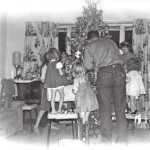
 Christmas Eve is a day full of tradition. Maybe not as much tradition as Christmas Day, but tradition nevertheless. For some people, the Christmas gifts are opened on that day, and for others, maybe just one gift is opened. It is the start of the Christmas holiday. When we think of the birth of Christ, we also think of nighttime. Maybe that is why Christmas eve is more special to us…whether we realize it or not. For Christians, Christmas is one of the special days, because it represents the day that hope arrived on the Earth again. Before that, there was no hope, whether the people knew it or not.
Christmas Eve is a day full of tradition. Maybe not as much tradition as Christmas Day, but tradition nevertheless. For some people, the Christmas gifts are opened on that day, and for others, maybe just one gift is opened. It is the start of the Christmas holiday. When we think of the birth of Christ, we also think of nighttime. Maybe that is why Christmas eve is more special to us…whether we realize it or not. For Christians, Christmas is one of the special days, because it represents the day that hope arrived on the Earth again. Before that, there was no hope, whether the people knew it or not.
For my grandparents, George and Harriet Byer, and my cousins, Raylynn and Doug Williams, it is a day to remember their wedding day, in addition to our Lord’s birth of course. In years gone by, people got married at times when the family could easily get together. I’m sure that is why Grandma and Grandpa chose that day. 
 For Raylynn and Doug, it seemed the perfect day, because of Grandma and Grandpa. I know that any day that a wedding takes place is special, but in our family, the Christmas Eve wedding is a very special one. It was what started the family.
For Raylynn and Doug, it seemed the perfect day, because of Grandma and Grandpa. I know that any day that a wedding takes place is special, but in our family, the Christmas Eve wedding is a very special one. It was what started the family.
Christmas Eve at my house, when I was growing up, meant singing Christmas carols and eating goodies, listening to Christmas music and watching Christmas movies. We got to open a gift too, and it was always pajamas. We knew it would be, but that was ok. We knew there would be pictures in the morning opening the gifts, and wearing those pajamas, all crisp and new, just made is Christmas somehow. In fact, I don’t think it would have been Christmas in my mind, without those new pajamas. I really miss my parents, Collene and Al Spencer at Christmastime.

 For most of us, there is some celebration on Christmas Eve. For my husband, Bob’s family, Christmas Eve meant Chili, and later the addition of Lasagna, and his mom, Joann Schulenberg’s homemade cinnamon rolls. Then they opened the gifts, and the kids had a great evening. Since my father-in-law, Walt Schulenberg’s passing, we have tried to continue that tradition, but we hadn’t had the cinnamon rolls, but my sister-in-law, Brenda wanted that tradition back. So, while they will not be like her mom’s cinnamon rolls, we will have them. Merry Christmas Eve everyone.
For most of us, there is some celebration on Christmas Eve. For my husband, Bob’s family, Christmas Eve meant Chili, and later the addition of Lasagna, and his mom, Joann Schulenberg’s homemade cinnamon rolls. Then they opened the gifts, and the kids had a great evening. Since my father-in-law, Walt Schulenberg’s passing, we have tried to continue that tradition, but we hadn’t had the cinnamon rolls, but my sister-in-law, Brenda wanted that tradition back. So, while they will not be like her mom’s cinnamon rolls, we will have them. Merry Christmas Eve everyone.
 With Valentine’s Day coming up tomorrow, everyone is buying candy and other goodies for their favorite valentine. In that spirit and in conjunction with the Super Bowl, our church always has a Chili Luncheon and Cake Auction. We bring in cakes, and then bid on them, paying insanely high prices to buy the things needed for the Sunday School classes. It is a great way to have a good time and see what great cooks we have in the church…and believe me, we have great cooks!!
With Valentine’s Day coming up tomorrow, everyone is buying candy and other goodies for their favorite valentine. In that spirit and in conjunction with the Super Bowl, our church always has a Chili Luncheon and Cake Auction. We bring in cakes, and then bid on them, paying insanely high prices to buy the things needed for the Sunday School classes. It is a great way to have a good time and see what great cooks we have in the church…and believe me, we have great cooks!!
My niece Jessi bid on and won a pink layer cake that she shared with the family at the luncheon, and it was amazing. It was what I would call the sleeper of the day, because had anyone known how amazing that cake was, Jessi would never have won the bid. Some of the well known cakes go for as much as $300.00, and this one would have been right up there. That said, I’m glad for us that no one knew, because we got to have it. It had like 4 layers, including a fruit topping and cream layers, along with the cake layers. It was absolutely Heavenly!!
Because the cake was pink, and in honor of the coming Valentine’s Day holiday, the perfect final touch was three red heart suckers. This worked out very well, because we had three little ones in our family that were there at that point, so they each got one of them. Now, anyone who has ever eaten a red sucker, or any other color for that matter, knows that all that pretty  color is going to show up on their tongue, and that was exactly what happened.
color is going to show up on their tongue, and that was exactly what happened.
Yes, all of them had the red tongue, but Aurora being a girl and a little older than her cousin Aleesia, is very into sticking out her tongue for the camera, just like the bigger girls do. I never could understand the whole sticking your tongue out thing. It reminds me of throat cultures, but the way Aurora does it is more like sticking your tongue out at someone you are mad at, except with a smile on her face. Because she likes doing that, she was happy to have me take her picture, so that everyone could see her Valentine Tongue.

